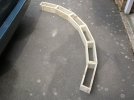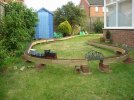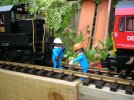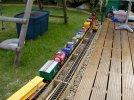Rhinochugger
Retired Oik
Probably not worth attempting.Gotcha! The one condition for me having a model railway in the garden is that my wife didn’t want to see it and it had to remain with my allotment area. Unfortunately putting it on the top it would be easily seen
What’s g-scale like with climbs? I could put a ramp up to it off a switch and just lay the track temporarily when needed.
So then, what you've got to do is have it at a raised level just inside that top timber rail so that the loco chimney is just visible as it goes by - that'll get her, and she'll allow you to put it in full view then




